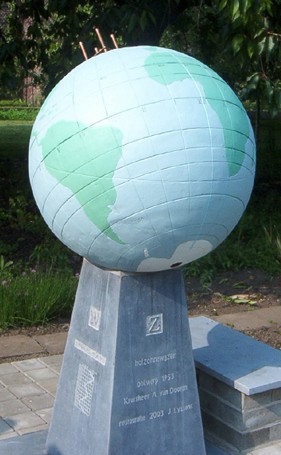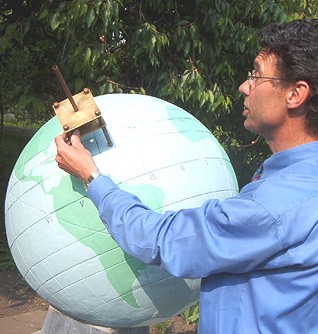
Sundial Park Genk
1. Armillary sphere

The earth's spinning motion is the origin of our daily rhythm, and its orbiting the sun brings us the seasons. See here the basis of time and date. What instrument can better visualize and measure these phenomena than a model of the earth? By riding piggyback on the earth, it too circles around the earth's axis daily and around the sun annually.
The thin rings and pole-style, combined with its generous size and subtle supports, give this armillary sphere an unmistakable elegance. In addition to the equatorial hour ring the tropic and polar circles are fit in, as well as the horizon ring and the local meridian. The dial shows local hours from 6 to 18 hr and is divided into 15-min units. The diameter of the sphere is 118 cm (almost 4 ft), so that one hour corresponds to 15.4 cm (6"). The pole-style is about 1 cm thick (0.4"); its shadow can nicely be read.
 |
 |
The north pole is capped with an equatorial disk dial. The time scale is divided into 2-hour units. The disk also has the location and its coordinates.
The sundial has been designed by Jan De Graeve, Vice President of the Flemish Sundial Society and project manager of the Sundial Park project, and was constructed by Julien Lyssens, President of the Society.
My comments:
The time scales
The earliest sunrise here is at about 3:40 hr local time, the latest sunset at about 20:20 hr. It is not clear to me why the hour scale does not span this entire range. The park's high trees probably block the sun during the early morning hours, but less so for the evening hours. Even then, it would have strengthened the educational value of this instrument.
The equatorial dial
The small equatorial dial on top has hour lines per two hours only. Why not per hour, or even per half-hour? And, again, why no broader range?
This dial will function only in the summer half-year. It would have been nice to have a similar dial at the south pole. Perhaps the sun would not reach it easily, but again it would add educational significance.
Inadequate construction
Elegant as this construction may be, it is not suitable for a public park. Not because of the threat of vandalism: nothing can withstand a determined vandal. In this case, the construction of the supports and the connection to the dial itself are plainly inadequate. This is not only true for the few centimeters of support in the east-west direction, but also for the somewhat wider support in the meridian plane, as the pictures show.
 |
 |
Other spherical dials
The model nature of the armillary sphere is not limited to the time and date functions. It can be and indeed was used also for astronomical, astrological, navigational and mathematical purposes. It may well have been the first analog computer...
Its scope can even be extended to geography, when a spherical map is added to the sphere. An example is the recently restored globe in the garden of the Crutched Friars monastery in Maaseik, some 25 km (15 ml) north-east of Genk. Starting from the local meridian, meridians have been drawn at 15° intervals, corresponding with one hour local time difference. The time can be measured by means of a small stand with a tube, which can be positioned perpendicular to the surface of the globe. When the sun shines through the tube, the meridian where it is noon right now has been located, and the local time for Maaseik can be read from the hour scale along the equator.
 |
 (Pictures by Willy Leenders, Belgium) |
Armillary spheres are also denoted as 'equatorial dials'. Another type of equatorial dial is the equatorial disk dial, like te one on top here. For more about equatorial dials and armillary spheres, see this page.
For more on spherical dials, see this page.